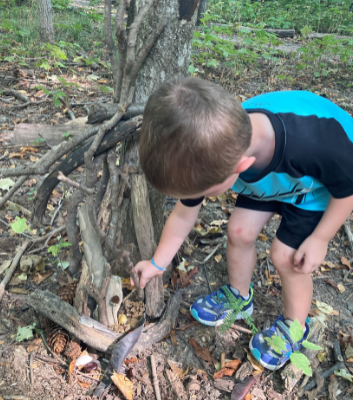It will soon be time to put our gardens to bed for the year. Fall is a perfect time to get the kids out in the garden, with the cool temperatures and changing of the season. Have them help you with some garden chores combined with fun activities, engagement with nature, and even learning too!
What kid doesn’t love to play in the dirt? Let them tear out any dead vegetables or annual plants from the garden or containers. Some will be like playing tug-o-war with the ground and others will find joy in flinging soil from head to toe when a plant pops loose. Browning perennials in the garden can be cut back to the ground too. Leave some of the taller perennials as habitat for overwintering insects and to provide some winter interest in the landscape.
Now create art with the dead plant material they just cleaned up! Use a variety of dried seeds and pods to create mosaics or natural art to display for the season. Preserve the gorgeous fall-colored leaves by pressing them between newspapers for several days to dry. The leaves can also be dipped in warm wax to protect them when dried and then used as decor. The kids can also make a fairy home under a shrub or tree using dried natural materials, creating a magical place for them to make-believe in nature.
Care for the wildlife in your yard and build a bug hotel to provide a natural habitat for overwintering pollinators and beneficial insects. Structures can be made from pallets, logs, or wooden boxes. Use dried leaves, evergreen tree cones, sticks, or straw to create different “rooms” in the hotel. Once your hotel is ready for occupants, take a stroll through your garden and look for the bugs that may take up residence in our new accommodations this winter. Plenty will be out in the cool fall temperatures.
Depending on the types of trees in your yard, an array of different colors and shapes of leaves may soon form a carpet on your lawn. Rake up the leaves in large piles and let the little ones jump into them. Or better yet, give them the rake to practice their gross motor skills and build upper body strength, both of which are essential for writing ability. After everyone is done playing in the leaves, use them as mulch for your garden. Leaves are a great source of free organic matter for gardeners. They can be chopped up with a lawnmower and added to the landscape or applied to a vegetable garden to help smother out any winter weeds. The decomposing leaves will be incorporated into the soil in the spring when you till.
Start planning for your spring garden and plant bulbs. The best time to plant spring bulbs is late September through October to allow enough time for a good root system to develop before winter. Youth can practice measuring and math skills while planting the bulbs. The general rule of thumb when planting is to bury them two to three times deeper than the length of the bulb, measured top to bottom. Bulbs should be spaced six to 12 inches apart to allow for spreading and future divisions.
ABOUT THE AUTHOR: Brittnay Haag is a Horticulture Educator with University of Illinois Extension, serving Livingston, McLean, and Woodford Counties. Her work focuses on youth horticulture education, specifically through school gardens and Jr. Master Gardener programs. Brittnay provides leadership for three county Master Gardener programs, and is responsible for developing community programs and providing expertise in horticulture and environmental sciences.
ABOUT EXTENSION: Illinois Extension leads public outreach for University of Illinois by translating research into action plans that allow Illinois families, businesses, and community leaders to solve problems, make informed decisions, and adapt to changes and opportunities.
